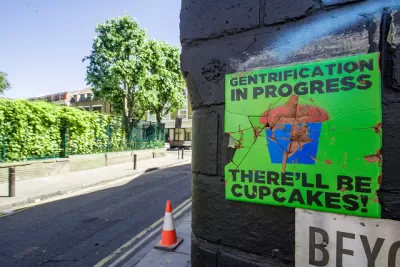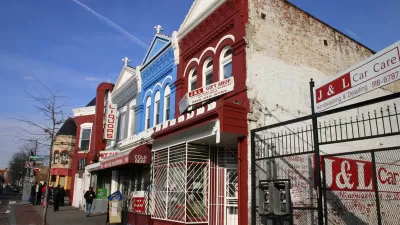The conversation about gentrification continually repackages a set of debunked theories as reality and it obscures a set of real crises that need fixing.

Gentrification has become a functionally useless term.
I don’t know when exactly I reached my breaking point on this issue, though I have been gradually phasing it out over four-plus years of studying neighborhood change. My guess is that it came somewhere between a ridiculous 2019 Jacobin article that claimed that graphic novels “are comic books, but gentrified,” or the turn in this summer’s Black Lives Matter protests when I started watching white people my age parade through Brooklyn screaming “fire, fire, gentrifier.” Whether they arrived here by birth or migration was impossible to tell, but at any rate it would have been impossible for them not to have ridden here on the ongoing “gentrification” wave that originated in the 1980s. If only we millennials had the ability to own our glass houses like so many NIMBY boomers did.
This is all to say that we have a major problem with how we talk about gentrification in this country, a fact true for people all across the political spectrum. First, because the conversation continually repackages a set of debunked theories as reality, and second, because it obscures a set of real crises that need fixing, namely, neighborhood-level inequality, the disappearance of affordable housing, and wages that have lagged behind the rising cost of shelter.
Let’s start by separating gentrification theory from reality. I’ll begin with the common narrative of gentrification, in which wealthy white people and developers move into poor neighborhoods and neighborhoods of color, directly displacing residents with the erection of new, fabulous apartments. This theory was introduced to the U.S. in the 1970s by geographer Neil Smith, but again it was a theory for explaining a new demographic pattern of people moving back to the city from suburbs—a hypothesis unconfirmed, something to be tested. Study after study that has tested it since, the best among them coming from scholars like Lance Freeman and Ingrid Gould Ellen (also, the Federal Reserve) find the theory insufficient.
Beginning with displacement, in a 2005 study covering over 31,000 households from 1980 to 2000, Freeman found that “mobility out of gentrifying neighborhoods is not necessarily dramatically different from mobility out of other neighborhoods.”
A little over a decade later, Ellen also found no significant differences in mobility among low-income residents who lived in gentrifying neighborhoods when tracking over 35,000 New York City children enrolled in Medicaid and who lived in market-rate apartments from 2009 to 2015.
Lastly, Quentin Brummet and Davin Reed, writing in 2019 for the Federal Reserve Bank of Philadelphia, found “moderate,” 4-6 percentage-point increases in mobility rates among less advantaged residents of gentrifying neighborhoods from 2000-2014 (the baseline mobility rate among all renters in the study was 70-80 percent), using a sample population of over 170,000 adults and children and a definition of gentrification based on educational attainment. Rather optimistically, their study also suggested that people who did move from gentrifying neighborhoods seldom ended up in worse-off locations, and that gentrification “creates some important benefits for original resident adults and children and few observable harms.” I’ll offer more on the half-truthfulness of this statement later on.
Next I’ll tackle race, where data along the Black-white fault line of urban segregation runs almost exactly counter to Smith’s theory: It has been the rare exception ...
FULL STORY: “Gentrification” Is Not the Real Problem

Planetizen Federal Action Tracker
A weekly monitor of how Trump’s orders and actions are impacting planners and planning in America.

Map: Where Senate Republicans Want to Sell Your Public Lands
For public land advocates, the Senate Republicans’ proposal to sell millions of acres of public land in the West is “the biggest fight of their careers.”

Restaurant Patios Were a Pandemic Win — Why Were They so Hard to Keep?
Social distancing requirements and changes in travel patterns prompted cities to pilot new uses for street and sidewalk space. Then it got complicated.

Platform Pilsner: Vancouver Transit Agency Releases... a Beer?
TransLink will receive a portion of every sale of the four-pack.

Toronto Weighs Cheaper Transit, Parking Hikes for Major Events
Special event rates would take effect during large festivals, sports games and concerts to ‘discourage driving, manage congestion and free up space for transit.”

Berlin to Consider Car-Free Zone Larger Than Manhattan
The area bound by the 22-mile Ringbahn would still allow 12 uses of a private automobile per year per person, and several other exemptions.
Urban Design for Planners 1: Software Tools
This six-course series explores essential urban design concepts using open source software and equips planners with the tools they need to participate fully in the urban design process.
Planning for Universal Design
Learn the tools for implementing Universal Design in planning regulations.
Heyer Gruel & Associates PA
JM Goldson LLC
Custer County Colorado
City of Camden Redevelopment Agency
City of Astoria
Transportation Research & Education Center (TREC) at Portland State University
Camden Redevelopment Agency
City of Claremont
Municipality of Princeton (NJ)





























